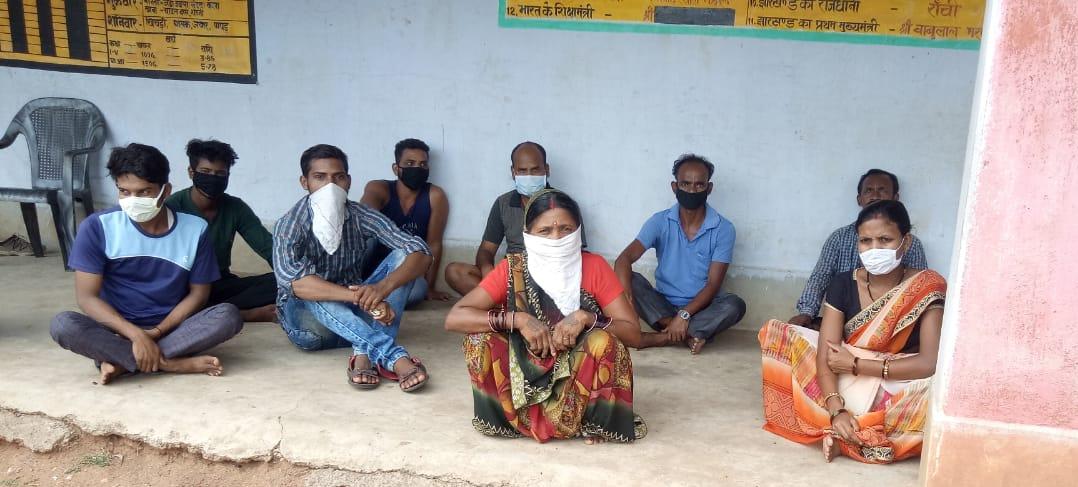Amid lack of transparency of train schedules, migrant labourers are still stranded in Maharashtra. They want to go back to their homes in Jharkhand.
As of now, Shramik Special Trains have not come to the rescue of these workers. While the government is pondering over bringing back the labourers stuck in the red zones of Maharashtra, these labourers are forced to pay as much as Rs 8,000 per head to travel by trucks or buses to their native places in Jharkhand.
Many of these have sold all their belongings to afford the travel expenses. “Some are selling their cell phones, some are selling gas cylinders. The truck driver was asking for Rs 8,000. I managed to borrow some money from my village. With that money, I have sent my younger brother home. If trains don’t run soon, then we may die here,” said Mohammad Junail Ansari, a labourer who is stranded in Mumbai’s Antop Hill area. He is living there with his wife and three children.
Like Junail, many labourers are trying to manage money for bus or truck fare. While these labourers are suffering because of the lack of transparency in the running of Shramik trains, the government is still pondering over bringing back these labourers home.
“Those who are going by trucks have to pay Rs 8,000 each. We have managed to pay for the fare and are now going to our homes in Jharkhand, the government could not do anything for us so we had to manage on our own,” said Naushad Ansari, who along with 25 other labourers is going back to Jharkhand.
Naushad informed us that he wasn’t getting food or water where he was stranded with 25 other workers. “Forget about getting food, we would even buy water for ourselves. For how long, could we have lived there without any work, ration or water?” asked Naushad. “At least, we will be able to do something when we reach our villages,” he added. Naushad lives in Kothi village in Bokaro district of Jharkhand, which is around 1,800 kms from Mumbai.
Besides trucks, these migrant labourers are using buses, auto rickshaws, taxis, motorcycles and even bicycles to go back home. Many of them were living in the red zones of the state but now they are going back without undergoing any screening.
On May 12, Yusuf, who arranged for two taxis in the Grant Road in Nagpara, which are among the red zones of Maharashtra, left for Jharkhand along with 10 other labourers. When Gaon Connection spoke to him, he had reached Nasik. He said, “We had no other choice, we just wanted to go to our homes. Even after the trains started running, we were forced to leave by taxi as there were no trains for us.”
Yusuf informed us that they had to pay Rs 10,000 per head for the taxi. When we asked him how he managed the fare expenses, he said: “We don’t even have money to buy food, we would arrange money for the fare once we reach our villages, but right now we have to reach our homes anyhow.”
Dil Mohammad, president, Al-Hind Educational and Welfare Society in Maharashtra, is helping migrant labourers. He has been requesting the government to run a Shramik special train for these labourers of Jharkhand.
“I have made a list of migrant labourers and mailed it to the government of Maharashtra and Jharkhand. Adequate information has been provided to the nodal officers who have been working here but they are not making anything clear even when repeatedly asked,” said Dil Mohammad.
“The government is not interested in bringing these labourers from hotspot areas; this is why Shramik trains from Maharashtra to Jharkhand are not running. But this way, the government will make things worse for these labourers. Only 4-5% of these workers have moved out, many labourers are still stuck,” he added.
To assist migrant labourers from Jharkhand stranded in different parts of the country, the Jharkhand government launched the Jharkhand Corona Sahayta mobile app. As of now, more than 5.50 lakh workers have registered themselves in this app. Of these, 65,000 labourers are from Maharashtra.
Many of these labourers have also been using the auto-rickshaws for travel. On May 12, a family of an autoworker met with an accident on the National Highway in Nagpur. In the accident, many labourers were badly injured. All of them hail from Western panchayat of Dumri police station in Giridih district of Jharkhand.
Besides, these labourers have also been buying old motorbikes to go home. Along with a few other labourers, Dilip Mahato, a labourer stuck in Navi Mumbai in Belapur has left for his home on motorbikes. When we spoke to him, he had reached Raipur.
Dilip said: “We have bought three old motorbikes from our employer. We had to pay Rs 10,000 for each bike. We have paid half of the amount and we will pay half when we come back.”
Besides, these migrants may create a problem for others once they reach home as they have moved from the red zones without undergoing any screening.
Sikandar Ali, a social activist, who has been helping these migrant labourers in Jharkhand, said: “We have been advising these labourers to come back only when the trains run. But they are not ready to stay there because they are unable to afford daily expenses there. Dharavi and Antop Hill in Maharashtra are COVID hotspots and a large number of labourers are stranded here.
Recently, two labourers from Surat came to Virni village in Jharkhand. They were tested corona positive, thereafter the entire village had to be sealed.”
“Those who have been coming were asked to stay in quarantine centres but they would flee from those centres. This may increase the spread of the virus. We have been requesting these workers to undergo screening before coming here. But they are desperate to come home,” added Sikandar.


















